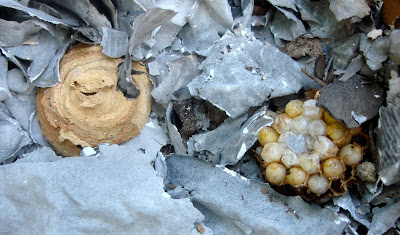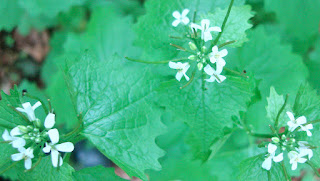Let me start off by saying that I am extremely allergic to bees. Like emergency room visit, full body hives, childhood marked off by weekly desensitizing shots, and Epi-Pen kind of allergic. So gardening brings along with it a certain amount of danger. I take great care to avoid all Hymenoptera--bees, wasps, and yellow jackets alike--and to not put any body part into a place where it is likely to be stung.
But sometimes bees make hives in the last place that you'd imagine. Over the years, we've had plenty of nests snuggled in behind shutters or angled into the corners of window jambs. That's where I expect to see their light brown papery houses and, during the summer, I keep an ear out to pinpoint their buzzing along the favored south side of the house. But where I don't anticipate a bee's nest is inside a pot of living plants.
Anyway, about a month ago, I had quickly dug up a clump of over-wintering sedums into order to plant several Coreopsis verticillata "Zagreb." Rather than transplant the sedums into their summertime pot right then, I simply tossed them into the container, doused them with water, and figured that they'd hang on just fine until I had a chance to do a proper re-planting. Yesterday, I was finally ready to compose my summertime succulent table centerpiece.
As I was lifting loose bunches of sedum from their temporary resting place, I grabbed a most peculiar plant from underneath the soil. At first, I thought that it was a downwards-growing spore sac or some crazy mixed-up version of hen-and-chicks, but as soon as I saw bees swarming, my own crazy mixed-up neurons began to fire in the most precise survivalist way, and I realized that I was holding a bee's nest.
I dropped the nest and stepped away so my non-allergic husband could take charge. Oh, yeah, there was a little hootin' and hollerin' involved. The hive fell to pieces; the brown paper walls and base shook loose from a neat little comb. Smoke from a small fire kept the bees away while the situation was assessed. In the end, we bagged up and discarded the comb. I am sympathic to the plight of honeybees, but a live comb was going to interfere with my future plans . . . like having a future . . . and I didn't like the idea of tossing the comb where some other possibly allergic soul could stumble into an accidental encounter. Meantime, a lone bee kept returning to the scene of the crime, buzzing low, and speeding away. Something poignant in his search . . . but, sentimentality aside, he was probably just flying on hard-wired autopilot.
Finally, the pot of succulents was assembled: hen and chicks Sempervivum sp., Sedum x "Vera Jameson," Sedum spurium "John Creech," and Sedum rupestre. Bees are welcome to visit.




















